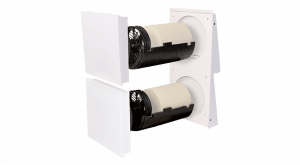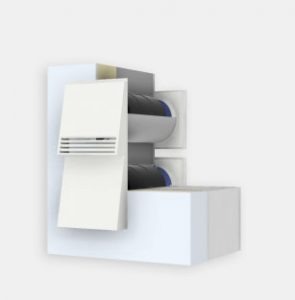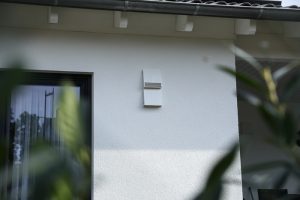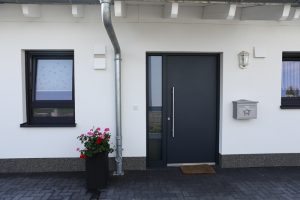Decentralised ventilation – operating principle
The ventilation of living spaces (residential ventilation), offices, public or commercial facilities can be realised via a decentralised ventilation system or decentralised fans. The functional principle of decentralised ventilation differs significantly from that of centralised ventilation. In the following, we at SEVentilation explain the possibilities of setting up a decentralised ventilation system and its functional principle (Decentralised ventilation – functional principle).
Structure of a decentralised ventilation system
A decentralised ventilation system with or without heat recovery can be constructed in different ways. Pure exhaust air systems differ from hybrid systems and systems with heat recovery. Decentralised ventilation systems from SEVentilation work according to the pendulum ventilation principle, which is explained schematically below. Controlled ventilation of individual rooms with so-called DUO or twin units is also possible. Ventilation units with a second room connection enable the ventilation of several rooms with one decentralised unit. In the following, the different possibilities as well as their advantages and disadvantages are shown. In practice, there can always be combinations and modifications in the individual systems.


Exhaust air system without heat recovery
In an exhaust air system, exhaust air fans such as the A160 are inserted into the exhaust air rooms such as the kitchen, bathroom or WC. Indoor kitchens or bathrooms are often vented via a central exhaust shaft. In order to ensure a sufficient supply air flow, fresh air diffusers such as the SEVi 160ALD are installed in the supply air rooms such as the living room, bedroom or children’s room.
Advantages:
- Easy installation and tool-free maintenance (with SEVi products)
- Favourable acquisition costs
Disadvantages:
- No heat recovery (no heating cost reduction and thus no crediting on the energy certificate).
- Uncontrolled, as dependent on external influences (e.g. wind)
- Heating up of the rooms in summer
Hybrid ventilation systems with extract air fans
Hybrid ventilation systems work with decentralised fans with heat recovery such as the SEVi 160 in living rooms and bedrooms and with demand-controlled extract air fans, such as the A160, in the individual extract air rooms. The living rooms and bedrooms are ventilated decentrally using the principle of pendulum ventilation (decentralised ventilation – operating principle). With this system design, living rooms are effectively ventilated with heat recovery and extract air rooms are ventilated cost-efficiently and demand-controlled.
Advantages:
- Easy installation and tool-free maintenance (for SEVi products).
- Relatively low purchase costs
- Partial heat recovery
- Controlled ventilation
- Optionally sensor-controlled
- Passive cooling of living spaces in summer
Disadvantages:
- No heat recovery in extract air rooms
- Higher acquisition costs than for exhaust air systems
Decentralised ventilation systems with heat recovery
Thanks to SEVentilation’s extensive product range, extract air rooms with and without external walls can also be ventilated energy-efficiently with heat recovery. Single room ventilation systems such as the SEVi 160DUO or the SEVi 160DUO Mini and a ventilation unit with a second room connection such as the SEVi Multi are available for this purpose. With the combination of individual room ventilation systems and the SEVi 160 ventilation systems, the energy-saving and controlled ventilation of entire utilisation units or properties with heat recovery is possible.
Advantages:
- Easy installation and tool-free maintenance (with SEVi products).
- Heat recovery of up to 90%
- Controlled, demand-controlled or sensor-controlled ventilation
- Passive cooling of living spaces in summer
- Medium acquisition costs
Individual room ventilation systems
With the SEVi 160DUO and the SEVi 160DUO Mini, even individual, moisture-intensive rooms such as kitchens or bathrooms can be ventilated effectively with heat recovery. These DUO or Twin units convey supply and extract air simultaneously. When using these products, individual rooms can be ventilated separately from other rooms in the utilisation unit.


Decentralised ventilation systems with two-room connection
With our new development SEVi Multi, it is possible to ventilate several rooms energy-efficiently with a decentralised ventilation system with enthalpy heat exchanger. The optional second room connection enables the integration of a second extract or supply air room into the ventilation concept, if there is an overflow area (e.g. corridor) between the extract and supply air room. Up to 3 rooms can be ventilated with the SEVi Multi. The duct connection allows, for example, indoor bathrooms to be integrated into a decentralised ventilation system.
In general, the same applies to decentralised ventilation systems as to centralised ventilation systems: Depending on the size of the air volume flow, sufficient overflow openings (e.g. door undercut) must be available.
Decentralised ventilation – operating principle – pendulum ventilation
Our decentralised ventilation systems such as the SEVi 160 work as a pendulum ventilation system in paired operation. As a regenerative system, the ceramic heat accumulator charges and discharges periodically at predefined intervals.
In the exact air phase, fan 1 transports the used, warm room air through the ceramic heat accumulator to the outside. In the process, the highly effective heat accumulator charges itself with heat energy from the room air and stores it. Simultaneously its paired fan 2 functions as a supply fan during this phase.
Both fans change the direction of rotation, they reverse. Fan 1 now draws in fresh outside air, which flows through a filter and the ceramic heat exchanger into the living space. During this process, the heat accumulator transfers its energy to the supply air flowing past and this flows into the living space already preheated. Meanwhile the paired fan 2 works as an exhaust fan. Both fans change their direction of rotation again. This is how the functional principle of decentralised ventilation with heat recovery in the pendulum ventilation mode can be described in brief (Decentralised ventilation – functional principle). Due to the back-pedal use of the ventilation units, these fans are also called reversing fans.